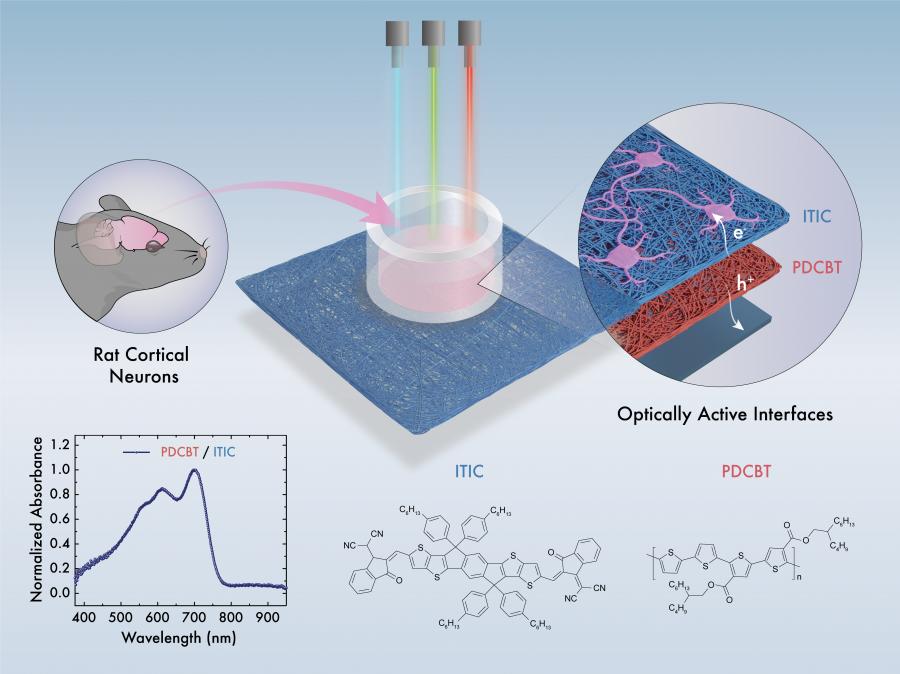MSc thesis project proposal
[2023] Light-Sensitive Bioelectronic Devices for Wireless Stimulation of Cells
Background: The use of light to control cellular activity has been widely used in clinical practice in different medical fields, such as oncology[1] and ophthalmology[2]. Recent advances in light-responsive, biomedical devices unlock new concepts, spanning from artificial vision[3] to wireless stimulation of the nervous system,[4] as well as tissue regeneration via phototherapy.[5] Recently, organic photo-actuators — devices that use organic semiconductors able to modulate cell activity with light — attracted significant interest because of relatively simple fabrication requirements and device setup,[6] biocompatibility, and strong absorption of light in the visible spectrum (i.e. wavelengths spanning from ~400 nm to 700 nm). Organic semiconductor thin films are usually deposited on transparent conducting substrates and are directly interfaced with cells that are cultured on their surface. Therefore, light can be absorbed by the photosensitive organic semiconductor and converted into a cue that modulates the activity of cells in close proximity. The profound advantages of low-intensity light stimulation as well as simplified, solution-processed fabrication, pave the way for the development of wireless bioelectronic devices for light-based therapy.
Aim: development of light-sensitive p-n junctions based on organic p-type and n-type semiconductors that operate stably in biological media. The development of opto-electrical instrumentation will be also targeted, to extract relationships between light intensity, stimulation frequency and photo-current generation. Overall, this work will establish important operating parameters for photo-stimulation of living tissue with organic semiconductors.
Literature
[1] M. R. Hamblin, S. T. Nelson, J. R. Strahan, Photomed. Laser Surg. 2018, 36, 241.
[2] W.-M. Chan, D. S. C. Lam, T. Y. Y. Lai, D. T. L. Liu, K. K. W. Li, Y. Yao, T.-H. Wong, Ophthalmology 2004, 111, 1576.
[3] J. F. Maya-Vetencourt, D. Ghezzi, M. R. Antognazza, E. Colombo, M. Mete, P. Feyen, A. Desii, A. Buschiazzo, M. Di Paolo, S. Di Marco, F. Ticconi, L. Emionite, D. Shmal, C. Marini, I. Donelli, G. Freddi, R. Maccarone, S. Bisti, G. Sambuceti, G. Pertile, G. Lanzani, F. Benfenati, Nat. Mater. 2017, 16, 681.
[4] M. Berggren, E. D. Głowacki, D. T. Simon, E. Stavrinidou, K. Tybrandt, Chem. Rev. 2022, DOI 10.1021/acs.chemrev.1c00390.
[5] S. Rohringer, W. Holnthoner, S. Chaudary, P. Slezak, E. Priglinger, M. Strassl, K. Pill, S. Mühleder, H. Redl, P. Dungel, Sci. Rep. 2017, 7, 10700.
[6] M. Silverå-Ejneby, M. Jakešová, J. J. Ferrero, L. Migliaccio, Z. Zhao, M. Berggren, D. Khodagholy, V. Đerek, J. Gelinas, E. D. Głowacki, bioRxiv 2020, 2020.07.01.182113.
Assignment
1st part: Literature review of light-sensitive devices for photo-stimulation of living tissue.
2nd part: Design, fabrication, and characterization of light sensitive bioelectronic devices based on p-type and n-type organic semiconductors.
Requirements
MSc students from Microelectronics, Biomedical Engineering or Mechanical Engineering. Interested students should contact Dr. Achilleas Savva (achilleas.savva@gmail.com), by including their CV, the list of courses attended, and a motivation letter.
Contact
dr. Achilleas Savva
Bioelectronics Group
Department of Microelectronics
Last modified: 2024-03-06
